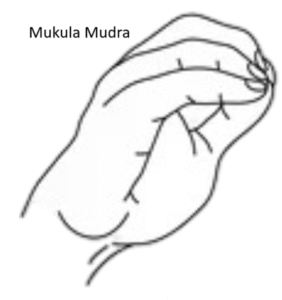Mukula Mudra
Introduction
Mukula Mudra, also called the “Beak Hand Mudra”, is a therapeutic hand gesture widely used in Mudra Therapy for healing and energy concentration. The word Mukula means “bud” in Sanskrit, symbolizing the potential energy of a flower about to bloom. This mudra focuses prana (life force) into a single point, making it highly effective for self-healing and energy direction. It is often applied directly to body parts that require healing or rejuvenation.
Meaning
Mukula = Bud (lotus bud or flower bud)
Mudra = Seal, gesture
Thus, Mukula Mudra represents the concentration of energy in a seed/bud form, symbolizing healing, regeneration, and renewal.
How to Perform Practice
Sit in a comfortable posture (Sukhasana, Vajrasana, or on a chair with spine upright).
Bring together the tips of all five fingers (thumb, index, middle, ring, and little finger).
Keep the palms relaxed, forming a “beak” shape with the fingers pointing forward.
Place the hands gently on the knees (for general practice) or directly on the body part needing healing (e.g., stomach for digestion, heart for emotional balance, head for concentration).
Close the eyes and breathe deeply, focusing on directing prana through the fingertips.
Practice for 5–15 minutes, once or twice daily.
Benefits
Physical Benefits
Directs prana (vital energy) to specific areas of the body.
Relieves fatigue, weakness, and exhaustion.
Supports healing of localized pain (e.g., stomach ache, headache, back pain).
Improves digestion and metabolism when placed on the solar plexus.
Promotes better blood circulation.
Mental & Emotional Benefits
Increases focus and inner awareness.
Reduces stress and anxiety by channeling scattered energy inward.
Brings a sense of centeredness and calm.
Spiritual Benefits
Helps in chakra healing when placed on specific chakras.
Enhances meditation by focusing energy at a single point.
Represents the seed state of spiritual potential.
Contraindications
Should not be practiced for very long durations (excessive prana concentration may cause restlessness in sensitive individuals).
Not recommended immediately after heavy meals (as it may disturb digestion).
People with severe psychological instability should use under guidance.
Anatomy & Physiology
Concentrates electromagnetic energy at the fingertips, which are rich in nerve endings.
Stimulates acupressure points linked to different organs.
Increases bioenergetic circulation in the applied area, supporting healing.
Enhances parasympathetic activation, promoting relaxation.
Kinesiology
Involves fine motor coordination of all fingers.
Engages small intrinsic muscles of the hand, especially lumbricals and interossei.
Supports postural balance by anchoring energy through the hand.
Neurology
Stimulates sensory and motor nerve endings in the fingers.
Activates somatosensory cortex representation of fingers, influencing brain-body connection.
Enhances vagal tone, aiding stress reduction.
Improves neuronal focus by directing energy consciously.
Duration of Mudra
General practice: 5–15 minutes, 2–3 times daily.
Therapeutic use: Place on affected area for 2–5 minutes, several times a day.
Can be practiced any time, but best done in a calm state, seated or lying down.
Counter Mudra
Prana Mudra → to recharge after energy focusing.
Apana Mudra → for grounding after healing practice.
Gyan Mudra → for mental relaxation after directed healing.
Conclusion
Mukula Mudra is a powerful healing mudra, often called the energy beak mudra, as it directs prana like a laser beam into specific areas of the body. It symbolizes the concentrated energy of a bud, carrying the potential for growth, renewal, and healing. Regular practice promotes physical rejuvenation, emotional balance, and spiritual focus, making it a versatile tool in mudra therapy.
FAQ
Q1: Can Mukula Mudra be used for any health issue?
Yes, it can be applied locally to support healing of many issues, but it should not replace medical treatment.
Q2: How often should I practice it?
At least once or twice daily for 10–15 minutes, or more frequently for targeted healing.
Q3: Can I do Mukula Mudra while lying down?
Yes, especially if applying it to an affected body part (like stomach or chest).
Q4: Is this mudra safe for children?
Yes, children can practice it, particularly for improving focus or calming down.
Q5: Does it help in meditation?
Yes, it helps in channeling energy and increasing concentration.
References
Swami Satyananda Saraswati – Asana, Pranayama, Mudra, Bandha
Gertrud Hirschi – Mudras: Yoga in Your Hands
Dr. Joseph Bharat Cornell – The Healing Power of Mudras
Bihar School of Yoga Publications
Dr. Indu Arora – Mudra: The Sacred Secret

